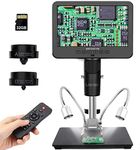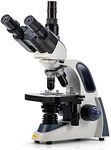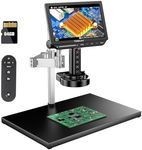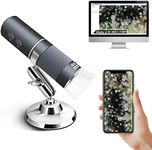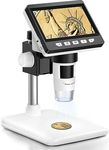Buying Guide for the Best Digital Microscopes
Choosing the right digital microscope can be a rewarding experience if you know what to look for. Digital microscopes are versatile tools used in various fields such as education, research, and hobbyist activities. To find the best fit for your needs, it's important to understand the key specifications and how they align with your intended use. Here are some essential specs to consider and how to navigate them.MagnificationMagnification refers to how much larger the microscope can make an object appear. This is crucial because it determines the level of detail you can see. Magnification levels can range from 20x to over 1000x. For basic educational purposes or hobbyist use, a lower magnification (20x-200x) might be sufficient. For more detailed scientific research, higher magnifications (200x-1000x) are necessary. Choose a magnification level based on the smallest details you need to observe.
ResolutionResolution is the ability of the microscope to distinguish between two points that are close together. Higher resolution provides clearer and more detailed images. Resolution is often measured in pixels for digital microscopes. For general use, a resolution of 2-5 megapixels is adequate. For professional or research purposes, higher resolutions (5-20 megapixels) are preferable. Consider what level of image clarity you need for your tasks.
LightingLighting is essential for viewing specimens clearly. Digital microscopes typically come with built-in LED lights. Adjustable lighting allows you to control the brightness and angle of light, which can be important for viewing different types of specimens. If you work with translucent or reflective materials, having good lighting control is crucial. Ensure the microscope has sufficient and adjustable lighting to meet your needs.
ConnectivityConnectivity options determine how you can view and share your microscope images. Common connectivity options include USB, Wi-Fi, and HDMI. USB is standard for connecting to computers, while Wi-Fi allows for wireless viewing on multiple devices. HDMI can be useful for displaying images on larger screens. Choose connectivity based on how you plan to use and share your microscope images. For classroom settings, Wi-Fi might be beneficial, while USB is great for individual use.
Software CompatibilitySoftware compatibility refers to the microscope's ability to work with various operating systems and software applications. This is important for capturing, analyzing, and sharing images. Ensure the microscope is compatible with your computer's operating system (Windows, Mac, Linux) and check if it comes with user-friendly software for image processing. Compatibility with third-party software can also be a plus if you need advanced features.
PortabilityPortability is about how easy it is to move and use the microscope in different locations. Some digital microscopes are compact and lightweight, making them easy to transport. Others are more robust and designed for stationary use. If you need to use the microscope in various locations, look for a portable model. For lab or classroom settings where the microscope will stay in one place, portability might be less of a concern.
DurabilityDurability refers to how well the microscope can withstand regular use and potential mishandling. This is particularly important in educational settings or fieldwork where the microscope might be subjected to rough handling. Look for models with sturdy construction and good build quality. If you need a microscope for rigorous use, prioritize durability to ensure it lasts longer.

